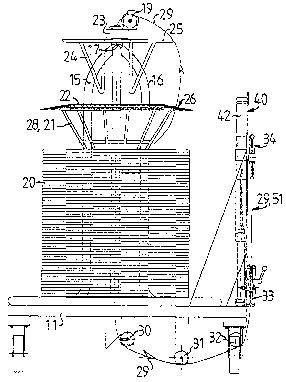Some of the information on this Web page has been provided by external sources. The Government of Canada is not responsible for the accuracy, reliability or currency of the information supplied by external sources. Users wishing to rely upon this information should consult directly with the source of the information. Content provided by external sources is not subject to official languages, privacy and accessibility requirements.
Any discrepancies in the text and image of the Claims and Abstract are due to differing posting times. Text of the Claims and Abstract are posted:
| (12) Patent Application: | (11) CA 2446114 |
|---|---|
| (54) English Title: | DEVICE AND METHOD OF REELING-OFF WIRE FROM A WIRE COIL |
| (54) French Title: | DISPOSITIF ET PROCEDE DE DEVIDAGE D'UN FIL A PARTIR D'UNE BOBINE DE FIL |
| Status: | Deemed Abandoned and Beyond the Period of Reinstatement - Pending Response to Notice of Disregarded Communication |
| (51) International Patent Classification (IPC): |
|
|---|---|
| (72) Inventors : |
|
| (73) Owners : |
|
| (71) Applicants : |
|
| (74) Agent: | SMART & BIGGAR LP |
| (74) Associate agent: | |
| (45) Issued: | |
| (86) PCT Filing Date: | 2002-04-18 |
| (87) Open to Public Inspection: | 2002-11-21 |
| Examination requested: | 2006-11-01 |
| Availability of licence: | N/A |
| Dedicated to the Public: | N/A |
| (25) Language of filing: | English |
| Patent Cooperation Treaty (PCT): | Yes |
|---|---|
| (86) PCT Filing Number: | PCT/SE2002/000761 |
| (87) International Publication Number: | SE2002000761 |
| (85) National Entry: | 2003-11-03 |
| (30) Application Priority Data: | ||||||
|---|---|---|---|---|---|---|
|
A wire consumer, a bale binder, draws wire (29) from a wire coil (20) on a
reeling-off device. The entire reeling-off device is mounted on a wheel-
supported frame (11), and it comprises means (33-35, 41-50), which form a wire
loop (51), which constitutes an acceleration balancer when the wire consumer
with a jerk starts to draw wire out from the reeling-off device. The means
forming the wire loop comprise a wheel (34), which is loaded by a spring (45),
and an air cylinder (46, 48), which is coupled to the wheel for damping the
acceleration of the wheel.
L'invention concerne un consommateur de fil, un cercleur de balles, tirant un fil (29) depuis une bobine de fil (20) installée sur un dispositif de dévidage. L'ensemble du dispositif de dévidage est monté sur un châssis (11) sur roues et comprend des moyens (33-35, 41-50) formant une boucle de fil (51) servant de dispositif d'équilibrage à l'accélération lorsque le consommateur de fil, par saccade, commence à tirer le fil hors du dispositif de dévidage. Les moyens formant la boucle de fil comprennent une roue (34) chargée par un ressort (45), et un vérin pneumatique (46, 48) couplé à la roue afin d'amortir l'accélération de la roue.
Note: Claims are shown in the official language in which they were submitted.
Note: Descriptions are shown in the official language in which they were submitted.

2024-08-01:As part of the Next Generation Patents (NGP) transition, the Canadian Patents Database (CPD) now contains a more detailed Event History, which replicates the Event Log of our new back-office solution.
Please note that "Inactive:" events refers to events no longer in use in our new back-office solution.
For a clearer understanding of the status of the application/patent presented on this page, the site Disclaimer , as well as the definitions for Patent , Event History , Maintenance Fee and Payment History should be consulted.
| Description | Date |
|---|---|
| Time Limit for Reversal Expired | 2008-04-18 |
| Application Not Reinstated by Deadline | 2008-04-18 |
| Deemed Abandoned - Failure to Respond to Maintenance Fee Notice | 2007-04-18 |
| Letter Sent | 2006-11-22 |
| Request for Examination Received | 2006-11-01 |
| Request for Examination Requirements Determined Compliant | 2006-11-01 |
| All Requirements for Examination Determined Compliant | 2006-11-01 |
| Inactive: IPC from MCD | 2006-03-12 |
| Inactive: IPC from MCD | 2006-03-12 |
| Inactive: IPC from MCD | 2006-03-12 |
| Inactive: Cover page published | 2004-01-15 |
| Letter Sent | 2004-01-13 |
| Inactive: Notice - National entry - No RFE | 2004-01-13 |
| Application Received - PCT | 2003-11-21 |
| National Entry Requirements Determined Compliant | 2003-11-03 |
| Application Published (Open to Public Inspection) | 2002-11-21 |
| Abandonment Date | Reason | Reinstatement Date |
|---|---|---|
| 2007-04-18 |
The last payment was received on 2006-03-23
Note : If the full payment has not been received on or before the date indicated, a further fee may be required which may be one of the following
Patent fees are adjusted on the 1st of January every year. The amounts above are the current amounts if received by December 31 of the current year.
Please refer to the CIPO
Patent Fees
web page to see all current fee amounts.
| Fee Type | Anniversary Year | Due Date | Paid Date |
|---|---|---|---|
| Basic national fee - standard | 2003-11-03 | ||
| Registration of a document | 2003-11-03 | ||
| MF (application, 2nd anniv.) - standard | 02 | 2004-04-19 | 2004-03-24 |
| MF (application, 3rd anniv.) - standard | 03 | 2005-04-18 | 2005-04-05 |
| MF (application, 4th anniv.) - standard | 04 | 2006-04-18 | 2006-03-23 |
| Request for examination - standard | 2006-11-01 |
Note: Records showing the ownership history in alphabetical order.
| Current Owners on Record |
|---|
| METSO PAPER, INC. |
| Past Owners on Record |
|---|
| FAHREDIN REXHAJ |